This is an AI Free Zone: Text created by Large Language Models is spreading across the Internet. It's well-written, but frequently inaccurate. If you find a mistake on Spaceweather.com, rest assured it was made by a real human being.
|
|
|
ALMOST NO CHANCE OF FLARES TODAY: Giant sunspot 4079 has just rotated off the western limb of the sun. This leaves the solar disk almost spotless. NOAA forcasters say there is no more than a 1% chance of M-class and/or X-class solar flares on May 12th. Solar flare alerts: SMS Text
THE ELECTRIC FOREST--TREES RESPOND TO A SOLAR ECLIPSE: Solar eclipses aren't just for homo sapiens. Researchers have long known that birds, insects, and many other mammals pay attention when the Moon slides in front of the sun. Now we can add trees to the list.
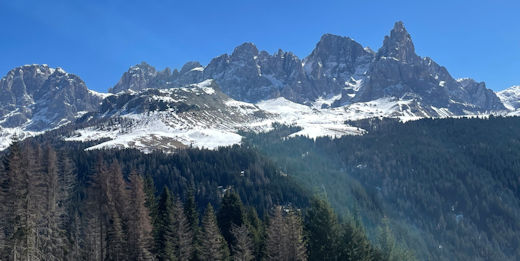
The study's location in the Dolomite Mountains of Italy. Photo credit: Monica Gagliano
A paper just published in the journal Royal Society Open Science reports the extraordinary reaction of an Italian mountain forest to a partial eclipse on Oct. 25, 2022. Electrical signals inside spruce trees began to pulse in unison, with older trees seeming to anticipate the eclipse before it happened.
This is unconventional research, and it may challenge what some readers think about trees. However, it is serious work conducted by experts in plant communication and published in a peer-reviewed journal of the Royal Society.
The paper reports how scientists led by Alessandro Chiolerio of the Italian Institute of Technology and Monica Gagliano of Southern Cross University attached electrodes to three Norway spruce trees and five tree stumps. Their device is like an EKG for trees. The trees were different ages, ranging from 20 to 70 years old, allowing the team to compare how age might influence bioelectrical responsiveness to the eclipse.
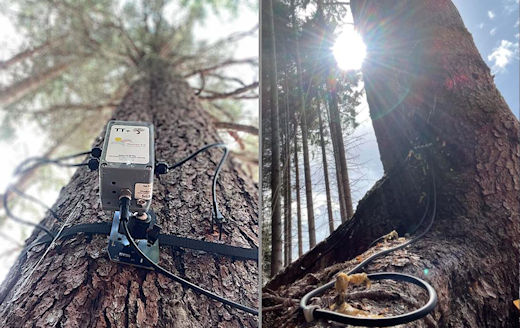
Electrodes connected to the spruce trees during the eclipse. Photo credit: Monica Gagliano
As the eclipse approached, electrical signals from different trees began to align; their waveforms became more similar in shape and timing. This synchronization peaked during the eclipse and gradually diminished afterward. The older trees started showing electrical changes earlier, hours before the eclipse began, while the youngest tree responded later and more weakly. The tree stumps also exhibited a bioelectrical response, albeit less pronounced than in the standing trees.
The researchers interpreted this as a coordinated "organism-like" response to a large-scale environmental event, possibly involving communication or shared signaling pathways.
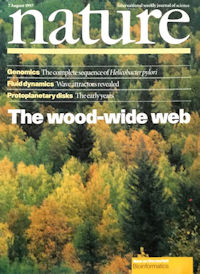 The idea that trees may "talk" to one another is key to the burgeoning field of plant communication. A growing body of research (especially since the 1990s) suggests that trees form symbiotic relationships with fungi, creating vast underground networks called the "Wood Wide Web." Through these networks, trees exchange nutrients, water, and even chemical signals. They also reportedly recognize their own young and give preferential treatment to kin. Even tree stumps may retain connections to this network.
The idea that trees may "talk" to one another is key to the burgeoning field of plant communication. A growing body of research (especially since the 1990s) suggests that trees form symbiotic relationships with fungi, creating vast underground networks called the "Wood Wide Web." Through these networks, trees exchange nutrients, water, and even chemical signals. They also reportedly recognize their own young and give preferential treatment to kin. Even tree stumps may retain connections to this network.
"Basically, we are watching the famous 'Wood Wide Web' in action!" says Gagliano.
Although the researchers successfully detected electrical activity in the trees, they have no idea what was being said--if anything. Perhaps it was simply a basic response to changes in temperature or light levels (about 1/3rd of the sun was covered during the eclipse). The researchers don't yet speak the "language" of arboreal electricity, so they can't decipher what they overheard. Repeating the experiment in different forests during more eclipses may be revealing.
Stay tuned for updates from the forest.
Recommended reading: Two good introductory books on plant communication and networking are "Finding the Mother Tree" by Suzanne Simard and "The Light Eaters" by Zoe Schlanger.
Realtime Space Weather Photo Gallery
Free: Spaceweather.com Newsletter
ROSE QUARTZ TREE OF LIFE PENDANT: You cannot buy this on Amazon. Only the Earth to Sky Store has the Rose Quartz Tree of Life Space Pendant. This one flew to the stratosphere March 4th onboard a cosmic ray research balloon:

You can have it for $129.95. The pendant's rose quartz gemstone is surrounded by a hand-wrapped stainless steel tree of life. During its 3-hour flight, it experienced temperatures as low as -63 C and air pressures less than 0.3% of sea level--truly, an out-of-this world gift!
The students are selling space jewelry to pay the helium bill for their high altitude ballooning program. Each pendant comes with a greeting card showing the item in flight and telling the story of its journey to the stratosphere and back again.
Far Out Gifts: Earth to Sky Store
All sales support hands-on STEM education
Realtime Aurora Photo Gallery
Free: Spaceweather.com Newsletter
Realtime Comet Photo Gallery
Free: Spaceweather.com Newsletter
Every night, a network
of
NASA
all-sky cameras scans the skies above the United
States for meteoritic fireballs. Automated software
maintained by NASA's Meteoroid Environment Office
calculates their orbits, velocity, penetration depth
in Earth's atmosphere and many other characteristics.
Daily results are presented here on Spaceweather.com.
On May 10, 2025, the network reported 11 fireballs.
(10 sporadics, 1 eta Aquarid)
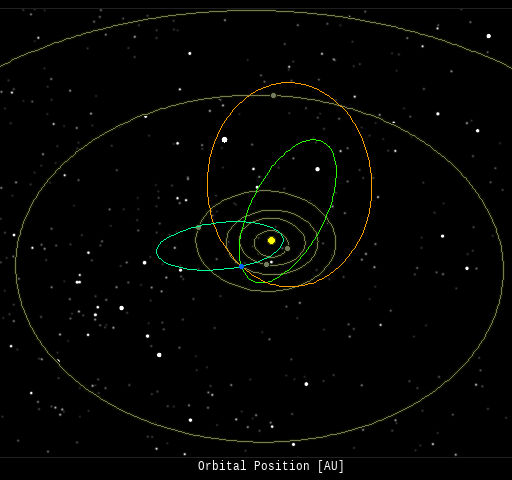
In this diagram of the inner solar system, all of the fireball orbits intersect at a single point--Earth. The orbits are color-coded by velocity, from slow (red) to fast (blue).
[Larger image] [movies]
Potentially Hazardous Asteroids (
PHAs)
are space rocks larger than approximately 100m that
can come closer to Earth than 0.05 AU. None of the
known PHAs is on a collision course with our planet,
although astronomers are finding
new
ones all the time.
On May 13, 2025 there were 2349 potentially hazardous asteroids.
 |
Recent
& Upcoming Earth-asteroid encounters:
| Asteroid |
Date(UT) |
Miss Distance |
Velocity (km/s) |
Diameter (m) |
| 2025 HY2 |
2025-May-07 |
17.8 LD |
13.6 |
38 |
| 2025 JF2 |
2025-May-07 |
11.9 LD |
16.7 |
23 |
| 2021 HZ |
2025-May-08 |
20 LD |
10.2 |
30 |
| 2025 JE |
2025-May-08 |
1 LD |
6.1 |
7 |
| 612356 |
2025-May-09 |
11 LD |
5.1 |
305 |
| 2025 JB2 |
2025-May-09 |
13.4 LD |
9.6 |
19 |
| 2021 KH |
2025-May-10 |
18.3 LD |
7.2 |
19 |
| 2025 JK1 |
2025-May-10 |
3.2 LD |
8 |
18 |
| 2025 JO |
2025-May-10 |
3.7 LD |
15.6 |
14 |
| 2025 JW1 |
2025-May-10 |
3 LD |
12.3 |
23 |
| 2025 JX1 |
2025-May-10 |
2.2 LD |
6.8 |
30 |
| 2025 JH2 |
2025-May-10 |
9.9 LD |
5.5 |
14 |
| 2025 JA1 |
2025-May-12 |
4 LD |
12.6 |
29 |
| 2011 HJ7 |
2025-May-12 |
6.6 LD |
15.8 |
118 |
| 2011 YU74 |
2025-May-13 |
11.4 LD |
5 |
90 |
| 2025 DT50 |
2025-May-14 |
16 LD |
6.4 |
105 |
| 2025 HD19 |
2025-May-17 |
7.3 LD |
9 |
27 |
| 2008 ST |
2025-May-20 |
13.5 LD |
2.5 |
14 |
| 2025 JE1 |
2025-May-20 |
11.4 LD |
1.4 |
22 |
| 387746 |
2025-May-24 |
17.4 LD |
8.3 |
339 |
| 2014 KF22 |
2025-May-25 |
9.1 LD |
11.5 |
19 |
| 390725 |
2025-May-25 |
18.4 LD |
13.5 |
410 |
| 2025 JP |
2025-May-27 |
13.4 LD |
7 |
24 |
| 2025 JR |
2025-May-28 |
12.1 LD |
11.4 |
76 |
| 2025 FU5 |
2025-May-28 |
13.4 LD |
7.3 |
92 |
| 2022 KP3 |
2025-May-30 |
10.2 LD |
7.7 |
7 |
| 424482 |
2025-Jun-05 |
9.1 LD |
6.2 |
421 |
| 2020 LQ |
2025-Jun-06 |
17.3 LD |
11.8 |
34 |
| 2018 LE4 |
2025-Jun-07 |
12.2 LD |
13.3 |
62 |
| 2014 LL26 |
2025-Jun-08 |
8 LD |
5.2 |
31 |
| 2022 KQ5 |
2025-Jun-12 |
13.6 LD |
5.1 |
5 |
| 2023 XO15 |
2025-Jun-15 |
17.8 LD |
3.4 |
24 |
| 2025 HN6 |
2025-Jun-16 |
6.4 LD |
2.3 |
23 |
| 2000 LF3 |
2025-Jun-17 |
18.9 LD |
14.5 |
169 |
| 2023 XU2 |
2025-Jun-18 |
11.1 LD |
15.6 |
32 |
| 2003 AY2 |
2025-Jun-22 |
14.2 LD |
15.9 |
386 |
| 2014 DH |
2025-Jun-28 |
17.1 LD |
12.1 |
17 |
| 2019 JM |
2025-Jul-09 |
16.6 LD |
6.9 |
14 |
| 2019 NW5 |
2025-Jul-09 |
15.2 LD |
16.5 |
65 |
Notes: LD means
"Lunar Distance." 1 LD = 384,401 km, the distance
between Earth and the Moon. 1 LD also equals 0.00256
AU.
| |
Cosmic Rays in the Atmosphere |
SPACE WEATHER BALLOON DATA: Almost once a week, Spaceweather.com and the students of Earth to Sky Calculus fly space weather balloons to the stratosphere over California. These balloons are equipped with sensors that detect secondary cosmic rays, a form of radiation from space that can penetrate all the way down to Earth's surface. Our monitoring program has been underway without interruption for 10 years, resulting in a unique dataset of in situ atmospheric measurements.
Latest results (Nov. 2024): Atmospheric radiation is sharply decreasing in 2024. Our latest measurements in November registered a 10-year low:
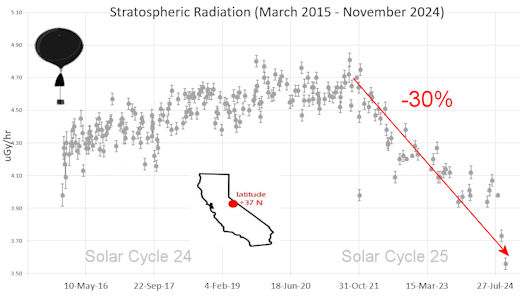
What's going on? Ironically, the radiation drop is caused by increasing solar activity. Solar Cycle 25 has roared to life faster than forecasters expected. The sun's strengthening and increasingly tangled magnetic field repels cosmic rays from deep space. In addition, solar coronal mass ejections (CMEs) sweep aside cosmic rays, causing sharp reductions called "Forbush Decreases." The two effects blend together to bring daily radiation levels down.
.Who cares? Cosmic rays are a surprisingly "down to Earth" form of space weather. They can alter the chemistry of the atmosphere, trigger lightning, and penetrate commercial airplanes. According to a study from the Harvard T.H. Chan school of public health, crews of aircraft have higher rates of cancer than the general population. The researchers listed cosmic rays, irregular sleep habits, and chemical contaminants as leading risk factors. A number of controversial studies (#1, #2, #3, #4) go even further, linking cosmic rays with cardiac arrhythmias and sudden cardiac death.
Technical notes: The radiation sensors onboard our helium balloons detect X-rays and gamma-rays in the energy range 10 keV to 20 MeV. These energies span the range of medical X-ray machines and airport security scanners.
Data points in the graph labeled "Stratospheric Radiation" correspond to the peak of the Regener-Pfotzer maximum, which lies about 67,000 feet above central California. When cosmic rays crash into Earth's atmosphere, they produce a spray of secondary particles that is most intense at the entrance to the stratosphere. Physicists Eric Regener and Georg Pfotzer discovered the maximum using balloons in the 1930s and it is what we are measuring today.
| |
The
official U.S. government space weather bureau |
| |
The
first place to look for information about sundogs,
pillars, rainbows and related phenomena. |
| |
Researchers
call it a "Hubble for the sun." SDO
is the most advanced solar observatory ever. |
| |
3D
views of the sun from NASA's Solar and Terrestrial
Relations Observatory |
| |
Realtime
and archival images of the Sun from SOHO. |
| |
information about sunspots based on the latest NOAA/USAF Active Region Summary |
| |
current counts of failed and deployed Starlink satellites from Jonathan's Space Page. See also, all satellite statistics. |
| |
Authoritative predictions of space junk and satellite re-entries |
| |
from
the NOAA Space Environment Center |
| |
fun to read, but should be taken with a grain of salt! Forecasts looking ahead more than a few days are often wrong. |
| |
from the NOAA Space Environment Center |
| |
the
underlying science of space weather |
 |
Got a chipped or cracked windshield that prevents you from seeing space weather events while driving? Get windshield replacement from SR Windows & Glass with free mobile auto glass service anywhere in the Phoenix area. |
 |
BestCSGOGambling is the best site for everything related to CSGO gambling on the web |
| |
These links help Spaceweather.com stay online. Thank you to our supporters! |
|
|
| |
|
|
|